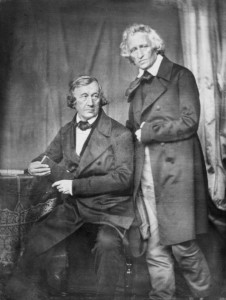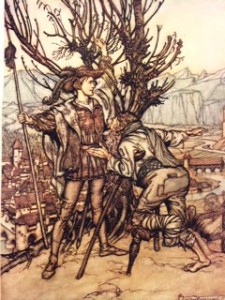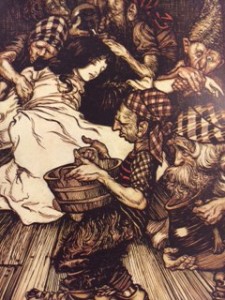BIOGRAPHY:
Brothers Jakob (1785-1863) and Wilhelm (1786-1859) Grimm were German academics, linguists and authors who specialized in studying folklore of the nineteenth century. Both attended the University of Marburg and while there, developed an interest in German folklore because of the rise of romanticism during this period (where folklore stood to emulate natural culture). The brothers published their first collection of stories, Kinder-und Hausmärchen (Tales of Children and the Home), in 1812, compiled of narratives from peasants and villagers. The Fairy Tales are an extension of this first publication, with more tales being added to the collection in each new publication. Jakob, more methodical and interested in research, provided the framework for the creation of the tales while Wilhelm focused on the style and mechanics of writing out the tales, revising everything from plot lines to thematic references. Editions of the Tales published by the brothers included numerous footnotes and annotations commenting on the origins and changes in each narrative.
In addition to their work on narratives of German folklore and legend, the brothers, were influential scholars in the field of linguistics, extensively studying German language and grammar. They developed what would become known as “Grimm’s Law,” “an unconditioned sound change, affecting all the stop consonants of Proto-Indo-European” languages (Brinton and Arnovik 570). For example, through applying Grimm’s Law, we can map the transition of the modern english words like “father” from the Latin “pater,” as Grimm’s Law states *p >*f (p sounds become f sounds).
After seven years as appointed librarians at the University of Göttingen, in 1837 the brothers were dismissed from their positions because of their political associations. They had joined the Göttingen Seven: a group of seven professors at the university who refused to swear oaths of allegiance to the King after he had dissolved the parliament of Hanover. The brothers eventually retained positions as professors in Berlin (around 1840) and remained there until their deaths.
The final years of the brothers’ lives were spent attempting to create a dictionary that would trace the origin of every German word in the German language. The Deutsches Wörterbuch was published in five installments, the first printed in 1854. It was a massive 1824 page scholarly resource yet it only got as far as the word “Biermolke.” Work on the Grimm’s dictionary has been carried on by numerous scholars after the brothers’ deaths and was finally completed in 1960 as a collection of 16 large volumes.
“WRITING” THE TALES:
Between its initial publication in 1812 and 1864, the Grimm’s Fairy Tales was published 17 times: seven “large” editions containing all of the tales collected to date with extensive annotations by the Grimm’s and ten “small” editions with 50 tales, intended for children. However, there are numerous misconceptions about the tales ranging from the intended audience of the text to its authenticity in relation to its authorship.
Firstly, while the tales were compiled and translated by the Grimm brothers, they were not stories of their own creation. The plot elements for the tales that would become a part of the Grimm’s collection were taken from German folk tales that were orally passed to the brothers by various villagers, tradesmen and townspeople. While the brothers were instrumental in translating the narratives and ensuring their stylistic cohesion for their own project, besides probable embellishment of certain aspects, the brothers did not come up with these stories themselves.
Additionally, while the title of the work is Fairy Tales of the Brothers Grimm and this would suggest that the work is appropriate for children, the tales were not initially produced for a young audience. Often, the stories included dark moments of extreme violence, sexual encounters, incest etc. in addition to the detailed notes and annotations from the brothers that would make it less than ideal for early readers. Further, beyond the necessary edits made to the stories, it is believed that Wilhelm added religious and spiritual motifs to the tales as well as utilized aspects of various mythologies (Greek, Roman, Norse) in creating the more child-friendly versions of the tales. Illustrations were not included in the earliest editions, only to be added later when alterations had been made and texts reflected changes that made the tales more suitable for a younger demographic. As the brothers’ Fairy Tales became more popular in the late 19th and 20th centuries, famous illustrators like Walter Crane, Edmund Dulac, and George Cruikshank (in addition to Arthur Rackham) were commissioned to provide illustrations for special, limited editions of the work.
Potentially most relevant to young adults and children in contemporary society is the influence of the tales on film adaptations of these “fairy tales.” Disney classics like Snow White, Sleeping Beauty and Cinderella draw their plot lines directly from the ideas of the Grimm Brothers’ tales. However, the saccharine fantasies that Disney depicts are a far cry from the dark narratives of the stories as they are given by the Grimm brothers. I can only imagine how traumatizing it would be to have one of my favourite movies growing up, Cinderella, altered to reflect the actual plot of the narrative. Watching the step-sisters chop off their toes and heels to fit their feet inside Cinderella’s lost glass slipper just doesn’t have the same magical tone…definitely not child appropriate!
References:
Brinton, Laurel and Leslie Arnovik. The English Language: A Linguistic History. New York: Oxford University Press, 2011. Print.
Tatar, Maria. The Hard Facts of the Grimms’ Fairy Tales. Princeton: Princeton University Press, 2003. Print.



